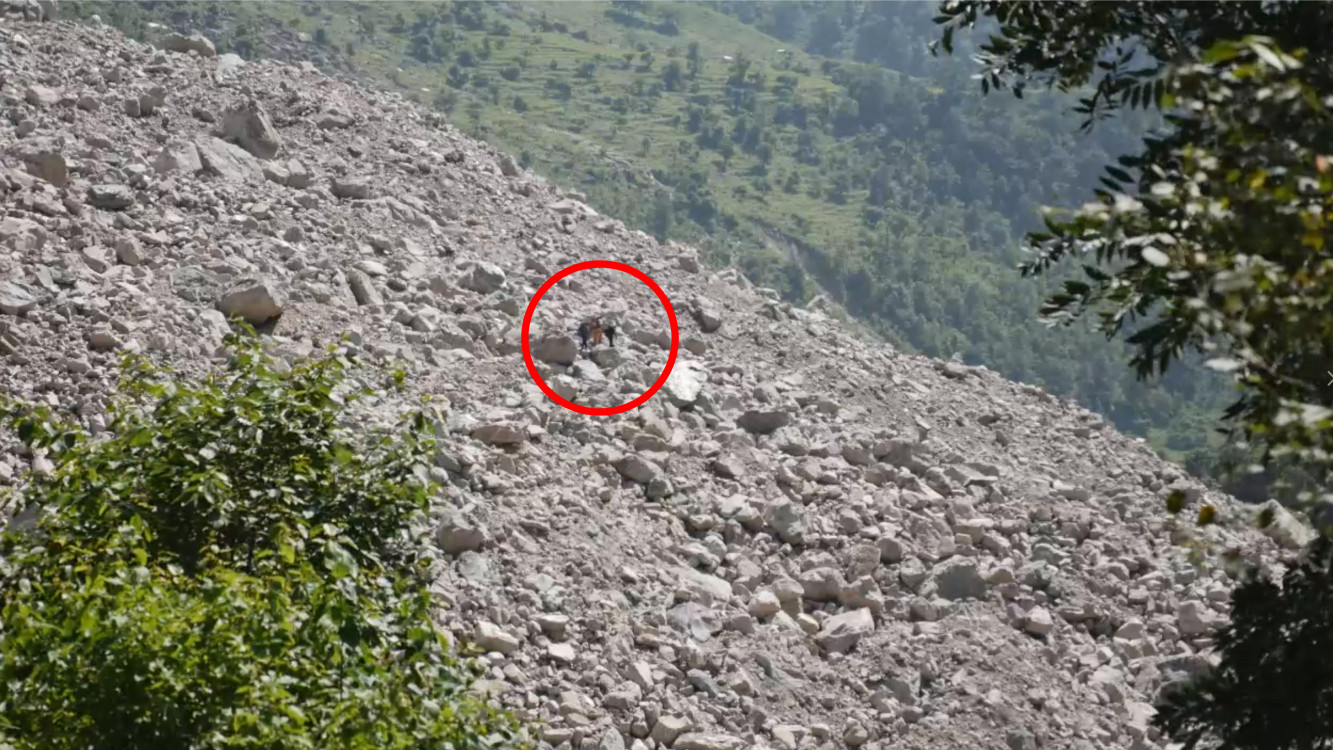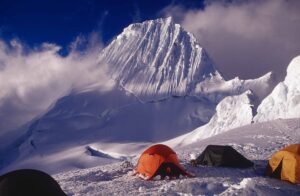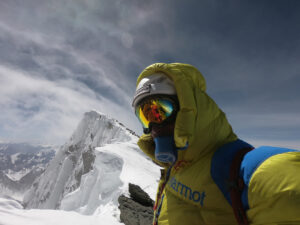Where there is a will, there is hope. In the autumn of 2015, Fredrik Sträng journeyed through his beloved Nepal. He found a country still scarred by the earthquake that claimed 9,000 lives and left 600,000 homeless. But he also found an inexhaustible determination to once again ascend the world’s highest peaks. Five years after the earthquakes, Nepal appears to have risen like a phoenix, but much of the rebuilding work remains, with approximately 100,000 people still living in temporary shelters, and the government facing criticism for its inefficiency in handling the disaster.
Article from January 2020
My journey begins in the spring of 2015, with text messages pouring in as I cross the Swedish border en route to Kiruna after a skiing camp in Lyngen, Norway. Are you in Nepal? Are you safe? I start searching for information about the earthquake, emailing and calling in hopes of reaching my friends in Nepal. I reach my friend Tommy Gustavsson, who, along with the renowned Wongchu Sherpa, has formed the successful recovery project savingmounteverest.org. “I have to do something,” is my immediate reaction when I speak with Tommy.
Two weeks after the earthquake, I organize a fundraising evening in Stockholm together with Everest climbers, Tommy Gustavsson, and the artist and Nepal enthusiast Martin Stenmarck. With us via satellite is Robin Trygg, who is on the ground in Nepal distributing sleeping bags and clothes to earthquake victims. We raise 163,822 SEK for the Red Cross’s emergency work in Nepal that evening. I raised another 100,000 SEK the following days.
Soygal Rinpoche once said that mercy is not true mercy if it does not lead to action. Avalokiteshvara, the Buddha of compassion, is often portrayed in Tibetan iconography with a thousand eyes that can see suffering in all forms in the universe and a thousand arms reaching out to help those who suffer. It’s not the thought that counts. If you can do something, it is your duty to do something.
A few weeks later, I was asked to seek funds for the reconstruction of villages devastated by landslides triggered by the earthquakes. I feel torn. Who is in the greatest need, and what should I do? By chance, I find Björn Söderberg’s blog, a social entrepreneur based in Nepal who has begun building earthquake-resistant houses. We discuss long-term solutions, and when a generous person donates 100,000 SEK that summer, I decide to use the money in the unknown and culturally preserved Rolwaling Valley, where my friend Chhiring Dorje Sherpa is from – the one I have been on four 8000-meter expeditions with.
Looks good in beard
– “My house is gone,” says Chhiring over a Skype call from the village of Beding, where he, as a child, ran barefoot and wrestled with disobedient yaks. That autumn, I combine house-building in Beding with an expedition to the world’s eighth highest mountain, Manaslu. The purpose is to document life after the earthquake. During the expedition, I am overwhelmed by the inadequate media coverage. Kathmandu, where it is convenient for all foreign journalists to travel, has been the focus of virtually all reporting, while villages in the mountainous regions around Gorkha and Langtang have received neither help nor attention.
I sit on a stool in a smoky teahouse in Sama Gaon. During our five-day hike to the village, we have passed three tourists. It’s frightening. Autumn is the peak season, and the teahouse is usually full of tourists. According to journalist and climber Billi Bierling, who manages the Himalayan Database, the percentage of tourists in Nepal decreased by 60 percent in 2015.
“But I think people will forget about the earthquake, and tourism will increase next year. Just look at Thailand after the tsunami,” she says. Even Tourism Minister Ananda Prasad Pokharel says the earthquake has hit the tourism industry hard. “According to reports, only three percent of trekking routes are damaged. But what people read in the media has a completely different psychological impact,” he says.
Laughter mixed with disappointment over the government’s lack of commitment to earthquake victims fills the smoky kitchen in Sama Gaon. An elderly man enters the room, moving slowly with a cane, and sits down beside me. His hands bear witness to a lifelong harvest of corn in the nearby fields. His face has seen many summers and many harsh winters. My camera attracts attention. I ask if I can take a picture of the elderly gentleman. When I show him the picture, he sheds a tear.
“It’s me!” he exclaims in surprise.
Tears continue to roll down his cheeks. It must have been a long time since he saw himself. “Looks good in beard,” he remarks.
Warmth echoes from everyone sitting in the small kitchen. In all hopelessness, there is comfort, a belief in the future. The villagers in the remote parts of Nepal are accustomed to fending for themselves. They do not expect any help from the government.
Buried under the rubble
My journey continues up Manaslu, and I meet several expedition leaders. Their concern is not so much that climbers are abandoning Nepal in times of crisis. Instead, it’s about the fact that the vast majority of tourists, the hikers, have chosen other destinations over Nepal.
“The earthquakes don’t affect climbers much. Mountains are dangerous regardless of whether there’s an earthquake or not, and it’s not the mountains that have changed, it’s the infrastructure. That’s why hikers have started turning to other alternatives,” says Russell Brice, founder of Himalayan Experience.
“There’s really no bad publicity for Mount Everest. History shows that the more Mount Everest is talked about, the more people want to climb it,” says Arnold Coster, CEO of Arnold Coster Expeditions.
There are an unusually high number of climbers on Manaslu this year. But appearances can be deceiving. Since China has chosen to ban climbing in Tibet “because of” the earthquake, many are choosing to travel to Manaslu instead. However, despite many opting to climb Manaslu, dissatisfaction is palpable among the villagers. Most climbers choose to fly in by helicopter to Sama Gaon instead of trekking in, which would benefit porters, local teahouses, motels, and drivers.
A few of us trek into Manaslu and back out. In hindsight, I realize that it was probably one of the most beautiful tours I’ve ever done in my life. Untouched nature, abundant wildlife, organically grown food, flowers, and greenery aplenty. However, the silence evokes strong emotions. On the way out, we see the remnants of landslides that are 600 meters wide at the base and started 800 meters above us.
“Many porters were on their way to Sama Gaon with goods when the landslide caught them by surprise,” Chhiring tells me as we step over a labyrinth of gigantic boulders. Among the rubble, I see clothes, shoes, and a backpack. The porters are buried right beneath us.
Helping hands
Meeting with the Red Cross in Kathmandu.
A hand-painted logo adorns the large iron gate that I step behind. The week after the earthquake, this garden was full of injured people seeking help.
“The earthquake was so big, and when it hit, millions of people rushed out onto the streets,” says Dev Ratna Dhakwa, secretary-general of the Red Cross in Nepal. He talks about the efforts that have been made and what is needed in the coming months and years for the reconstruction work to continue.
“We need to increase tourism. Nepal has received a lot of negative publicity, and it has negatively affected tourism,” says Dhakwa.
In the afternoon – after a heavy downpour – I meet Ani Kerom, a Swedish nun who has spent the last 30 years at the Kopan monastery in Kathmandu. She exudes a sense of calm. We sit in the beautiful garden, and the students’ meditation is accompanied by sporadic flights coming in for landing at Tribhuvan International Airport.
“It takes a disaster to bring people together,” says Ani.
I ask her what we can learn from the earthquake.
“In the monastery, there are many helping hands. When the earthquake struck, everyone in the monastery united, and Dharma was put into practice. They went out to help others in need and did so with great joy. They were trained to do so. Now they had the opportunity to do so.”
My last meeting that day is with Declan Murphy, a social entrepreneur who came to Nepal in 2003 to work as a teacher in a school in the Everest region. He remembers when he was young and witnessed a massacre in Somalia. Then he asked himself, “What can I really do about it?” Ten years later, when he saw starving children in Ethiopia, he asked himself the same question.
But one day, full of guilt and anger, he instead asked himself, “But maybe I can do something?”
“Handing a cookie to a street child might make a tourist feel a little better, but it doesn’t help. It just encourages the children to stay on the streets. When we perform an action, we must be aware of what we are doing; we must question our motives. We must contribute to something long-term, and you do that by coming here as a tourist. The taxi driver, the souvenir shop, the guide, the chef; everyone benefits from your stay!”
Dreams of the future
The leaves on the trees are turning into golden reds and yellows. When my friend Chhiring Dorje Sherpa created the Chhiring Foundation after the earthquake, he wanted to contribute to the rebuilding of his village and the Rolwaling Valley.
“So much has been destroyed here. I want those who live here to have better conditions for a more comfortable life,” says Chhiring.
We enter a small community just outside Beding. Here, nine houses have collapsed from large rockslides. Even the house where Chhiring was born is completely destroyed. He walks around among the house ruins and looks through the roof that was hit by a boulder the size of a car. He tells me that his oldest sister passed away in this house some time ago and that his younger brother died here in 1995.
He begins to cough. Tries to hold back the tears but can’t. His eyes turn red, and tears start rolling down his cheeks. Dr. Erik Meyer, a lifelong friend, hugs him.
“Right now, I have many good friends around me, but mostly I am sad,” says Chhiring as we sit on some rocks beside the house and contemplate the transience of life.
He organizes a charity trek to Rolwaling for some Americans, a Japanese, and me. The money goes exclusively to the teahouses and porters from the village. During dinner in Beding, Chhiring talks about his plan.
“My dream is to climb all the mountains over 8000 meters. When I’m done, I’m going to build a hotel up here with 14 rooms – one for each mountain – to support the community in Rolwaling.”
It’s strange. Most people choose to go to Mount Everest Base Camp, because Mount Everest is the highest mountain in the world. And here we are, in Rolwaling, where mountains of 6000 and 7000 meters stand like dramatic snow-covered spears a couple of hours’ walk from the narrow valley. No other tourists are here to experience an untouched culture with sacred places and spiritual monasteries.
A week later, we climb up to a “small” trekking peak called Yalung Ri, which the community in Rolwaling has fought for years to gain rights to.
“Finally, Yalung Ri is free from the Nepal Tourism Ministry,” says Chhiring, explaining that they can now administer permits for this mountain themselves and thereby use the money from climbing permits for the community instead of the government taking the money. Dissatisfaction with the government is high among Sherpas, and in November, they plan to protest outside the Tourism Ministry’s doors to get better conditions for those working in the mountains.
A Love Affair
Filled with peace and tranquility, I return once again to Kathmandu. The efforts to restore cultural heritage continue, and organizers look back on 2015 as a bleak year for their operations but are hopeful for a favorable 2016. I receive reports of several volunteers who dropped everything and focused on relief work when the earthquake struck Nepal.
One of these stories comes from Avrati Bhatnagar, who had just married her husband Anurag Bhattarai. Anurag sat in front of the computer in India and searched for news about the disaster for days. Then he stood up and said, “I have to do something.” Without hesitation, the newlyweds traveled to Kathmandu.
They started on a small scale. They bought rice, lentils, tarpaulins, candles, matches, and soap, and packed them into bags. The word spread, and after just a couple of weeks, there were about fifty people working practically around the clock to pack bags of relief supplies for the affected districts in Nepal.
When I meet Avrati, she lights up when she talks about the relief work.
“Everyone is suffering, but it’s also something that binds us together, perhaps more than happiness. I think we have an impulse to help others. It’s a good reaction. Maybe it’s the case that you feel the crisis less if you help,” she says.
I look back on 2015 and send hopeful thoughts for a successful 2016 for Nepal. I have already decided to return in the spring and to start organizing expeditions to Mount Everest that can benefit the Nepalese economy.
The goal is also to build more houses, but this time in the hard-hit village of Langtang, which was literally buried by landslides. I receive reports from Tommy Gustavsson, who has decided to settle in Namche Bazaar in the Khumbu Valley. I think Nepal has an enchanting effect on us as tourists there. Once is not enough, as Tourism Minister Ananda Prasad Pokharel told me in the fall of 2015.
It’s not hard to fall in love with this country, these people. I look back on the encounters with the few tourists I met during my journey. When they tried to explain their impressions of Nepal, it can be summed up as “People, kindness, adventure, mountains, fantastic views, interesting history, Sherpas, everything smiles at you.”
I thank Avrati for allowing me to interview her and wish them luck with their project to build schools. Before we part ways for this time, she tells me one last thing.
“You see, every effort counts, every drop contributes to an ocean.”
What was the situation in 2020?
The economic losses from the earthquake were estimated at $10 billion, which is approximately one-third of Nepal’s GDP. Approximately 100,000 people or more still live in makeshift housing. UNESCO is collaborating with the government in a major campaign to restore damage to 700 temples, palaces, and museums, including 137 that completely collapsed in the earthquakes.
The National Reconstruction Authority’s housing grant is $3,000 to each affected family but has still not been accepted by all those entitled to it. The authority’s chairman, Mr. Sushil Gyewali, told the media that an additional $4.29 billion is needed “to complete the reconstruction of structures destroyed by the earthquake.”
Nepal still lacks effective and enforceable mechanisms to monitor the use of humanitarian aid. Having the money is not enough; it must reach the projects that truly help people.
UN Settlements Coordinator Valerie Julliand expressed concern for those who were the most vulnerable before the earthquake and whose needs have not been met.
Julliand continues: “Their needs go beyond a simple grant. Their exceptions are at a different level and have different faces. The people who are excluded are excluded because of their gender, caste, ethnicity, and they may not be able to read or write, they may not know how to seek support. “In general, we see that the most excluded in society are those who need the most attention from us.”
Fotnote: Next year marks the 10th anniversary of the Gorkah earthquake. How can we help? Simply by visiting Nepal. I will be organizing climbs to Nepal where you are invited to join. Interested? Send me a message!
About Fredrik Sträng: Fredrik, in his leadership role, has climbed seven of the Earth’s fourteen 8,000m peaks, set a Guinness World Record, and lectures on leadership, communication, decision-making, and crisis management.
Best regards, Fredrik Sträng Alpinist – Speaker – Coach







